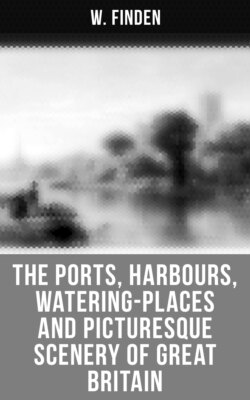Читать книгу The Ports, Harbours, Watering-places and Picturesque Scenery of Great Britain - W. Finden - Страница 22
На сайте Литреса книга снята с продажи.
SHIELDS.
ENTRANCE TO THE HARBOUR.
ОглавлениеTable of Contents
The view of the entrance to Shields Harbour is taken from the bank a little below the Spanish Battery, on the north side of the Tyne, and about a quarter of a mile to the south-westward of Tynemouth lighthouse. To the left, a part of South Shields is seen, with a vessel "dropping up" the Narrows, just before entering the harbour. Towards the middle of the Engraving are the two lighthouses at North Shields—distinguished by their flag-staffs—which, when taken in a line, are a guide for vessels in passing the bar. To the right of the low lighthouse is Clifford's Fort, enclosed by the line of embrasures, and commanding the entrance to the harbour. To the right are the banks, of clay, which extend from the Spanish Battery to the Low Lights, and upon which the sea is every year gradually making encroachments. The present Engraving, independent of its beauty as a work of art, possesses the merit of containing the only correct view of the entrance to Shields Harbour which has hitherto appeared.
That portion of the river Tyne which may be considered as Shields Harbour is about a mile and a half in length, supposing it to commence at the Low Lights, on the north side, and to terminate at the lower end of Jarrow Slake, at the head of South Shields; its direction is from east by north to west by south; and the towns of North and South Shields are built on the banks and by the shore on each side of it. As the Low Lights are about a mile within the bar, the swell of the sea is not felt within the harbour.
The river is of unequal width, being in some places not more than 400 yards broad, while in others, when the sands are covered with the tide, its width is upwards of 600. From the shoals and varying width of the river, the velocity of the current differs with the breadth of the harbour. Opposite to the New Quay at North Shields, the average velocity in the middle of the tide-way is, at half flood, about three miles an hour; and, at half ebb, about three miles and three quarters an hour. As the easterly wind blows directly into the harbour, vessels formerly were often hindered from getting out to sea, even in fine weather, when the wind was in that quarter, more especially if they were of considerable draught of water; for frequently before such a vessel could drop down with the ebbing tide as far as the bar, there was not sufficient depth of water on it to allow her to proceed to sea. The general introduction, however, of steam-boats for the purpose of towing vessels, when the wind is shy or contrary, has, in a great measure, remedied this inconvenience, and vessels now proceed to sea at any time, in favourable weather, when there is a sufficient depth of water on the bar.
The town of South Shields is very irregularly built; and the principal street for business extends from the market-place to the lower end of the town. The market-place, in the centre of which stands the town hall, is spacious, but the market is very indifferently supplied with every thing except fish. Westoe, anciently Wivestoe, is a pleasant village about a mile southward of South Shields, where several ship-owners and persons of property reside. Jarrow, so famous in days of yore for its monastery, is about a mile and a half to the westward of Westoe; and in the vestry an old chair is still preserved, which is said to have been the seat of the venerable Bede.
The town of North Shields lies on the north side of the river Tyne, and is in the county of Northumberland. The principal street for business, and which may be considered as forming the greater part of the old town, is the Low-street, running nearly parallel with, and at a short distance from, the river, and extending from the New Quay to the Low Lights. The greater part of the town, which is built on the bank top, extending in regular streets towards the north, has been erected within the last fifty years.
At the New Quay there is a commodious wharf, with warehouses at each end, where trading vessels load and unload, and where steam-boats leave for Newcastle. A little above the New Quay is the landing for the steam ferry-boat, which plies between North and South Shields, and leaves each place four times an hour, from seven in the morning till dusk, carrying passengers across the river at the charge of a penny each. This ferry, which was only established in 1829, is a great accommodation to both the towns. Previous to its establishment, the conveyance of sheep, cattle, and horses across the Tyne, in an awkward flat-bottomed boat, managed by a single man, was attended with great inconvenience. The barge steam ferry-boats now employed are surrounded with a strong railing; and sheep, cattle, and horses can be driven on board with little trouble, and conveyed across the river without risk.
NEWCASTLE-UPON-TYNE.
